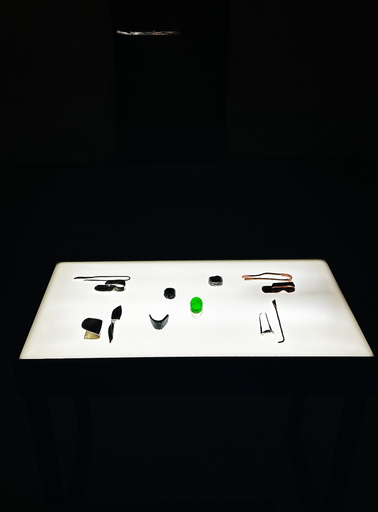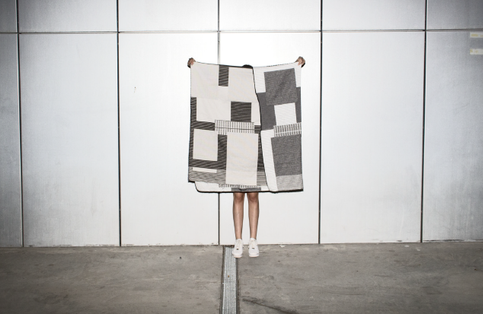J a n n e C l a e s
"come for dessert"
In the research titled “De (on)eindigheid van het (on)gecontroleerde”, I explore how we interact with objects and how the value attributed to a specific object can shift in a specific context. I do this by abstracting the expected function of an object and then rearrange these “ideas of functionality”. By doing this, a new idiom is created, wherein an endlessness in composition and a constant ability to change is the central course.
For this exhibition, I developed my materials and visual language even further, presenting an edible iteration titled
“Come for Dessert”.
The exhibition and performance took place in the gallery “Dingen die niet Verkopen” at Oude Beurs 62, Antwerp.
For this exhibition, I invited artist-cook Isabelle van Lieshout to bring this new perspective on the objects to life.
The objects can be consumed by the visitors during the course of exhibition.
scenario "come for dessert"
When one enters a space, any space, there is a staged setting displayed in the way the maker of the space imagined. The way humans will experience the objects & the space, is a pre-determined scenario.
The space is stopped in time and picked apart by it’s maker and has taken the essential things with it, to then be installed again in a new context on a different location. The space, is an atelier, a working place or laboratorium.
The spatial planning will be experienced here by means of rack, light-box and diaprojector on floor 0, as well as a light-table on floor -1.
The shapes / bodies / objects in this space are developed from materials that start from nothingas raw material and are developed into something as a form. The idea is that these materials can be used and re-used by which the most essential aspect of continuity is kept in stance.
On floor -1 a new situation is created that introduces a duality of value between object and materiality—a valued utility that is reshaped into a functionality related to the objects made from materials that can be temporarily presented and processed through human contact.
The light-box marks the beginning of the research title “de (on)eindigheid van het (on)gecontroleerde”. It embodies the idea that an induced state of flux and endlessness in compositional possibilities is made possible—that there is a constant possibility for change. This concept originates from the maker’s inspiration, seeing the light box both as a tool for presentation and as a tool for drawing.
The rack refers to archiving and preserving the different possibilities within objects and materials. It makes it an inexhaustible source of information.
The table is a moment of confluence, dining, experiencing
When one has wandered through the space, one shall engage in finding that: The triptych – object, matter, spatial completion – is essential in the creation of new meanings and continuity. Through this, these elements question the value of object and form.
“ what is the value of objects in a context”
When one enters a space, any space, there is a staged setting displayed in the way the maker of the space imagined. The way humans will experience the objects & the space, is a pre-determined scenario.
The space is stopped in time and picked apart by it’s maker and has taken the essential things with it, to then be installed again in a new context on a a different location. The space, is an atelier, a working place or laboratorium.
Scenario 1.3
The spatial planning will be experienced here by means of a rack, table, light-box and television.
First there is a film shown. In the film there is a setup of the essential things that are reinstalled by the maker in a different space. The experience of the object & the spatiality becomes different. It is the introduction to a scenario what could be experienced or played in the “now” in the current space.
The shapes / bodies / objects in this space are developed from materials that start from nothing but are developed into something. The idea is that these materials can be used and re-used all the time by which the most essential part of continuity is kept in stance.
The light-box is a start of the work with the title “de (on)eindigheid van het (on)gecontroleerde”. It is the beginning of the idea that an induced state of flux and endlessness in compositional possibilities is made possible. That there is a constant possibility for change. This originated because the maker is inspired by the light-box being a tool for presentation and a tool for drawing.
The rack refers to archiving and saving the different possibilities within objects and materials. It makes it an inexhaustible source of information.
The table is a moment of confluence, dining, communicating…
When one has wandered through the space, one shall engage in finding that: The triptych – object, matter, spatial completion – is essential in the creation of new meanings and continuity. Hereby, these elements question the value of object and form.
Staged installation by Janne Claes
Video by Marnik A. Boekaerts
Music by Kobe Boon & Heleen Andriessen
Bodies, Pascaline Van Hooff & Jonas Wellens
Location, Firma
Link: https://vimeo.com/288431599
De (on)eindigheid van het (on)gecontroleerd - Archivo
Staged installation by Janne Claes
zwarte zaal KASK
"Comp.5261563" - Archivo
An in between spatial research to form and different material combinations in hard and soft material who can be connected visual or fysical.
"As I Was walking Through Cities"-Archivo
As I was walking through cities, I was making pictures of the architecture.
Noticing the buildings that I photographed had the same structure most of the time. And my photos focus on the lines in the buildings (horizontal-vertical).The pictures I would later interpreted, and translate into drawings, My drawings are the beginning for different suggestions in my pieces. A continuation for my compositions on which I base the selection of materials and qualities I want to use. Their feel, atmosphere can be found in my drawings. To put this in an actual piece, I began folding my fabric. Folds that I change during my process.The compositions will evolve naturally over time, as I process and develop my designs further. Tending to make the same evolutions in compositions, as the evolution in the structures I photographed.
The research led to black on black - white on white - black on white - white on black compositions. The dark colors with different greyscales,Related to the use of colors, the quality of the textile is important, Using less color makes it more interesting to play and combine different materials and to get gradients and an (smooth) evolution with (small) accents.
Key words in this work:
BINDINGS/ COMPOSITIONS OF THE DRAWINGS, DIFFERENT MATERIALS WHO ARE RELATED TO MY DRAWINGS THESE DRAWINGS WHO ARE AGAIN RELATED TO MY PICTURES. /THE COMPOSITION OF THE FOLDS_





















